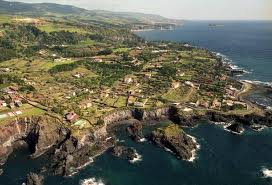CALOURA
A Caloura é uma aldeia açoriana localizada em Vale de Cabaços, pertencente a Água de Pau, concelho da Lagoa, ilha de São Miguel, arquipélago dos Açores. Nesta localidade encontra-se um dos mais antigos conventos da ilha de São Miguel, o Convento da Caloura que se encontra classificado como Imóvel de Interesse Público pelo Governo Regional dos Açores. É também na Caloura que para defesa da orla costeira foi edificada a Bateria de Nossa Senhora da Conceição de Caloura. É terra de produção de vinho com particular predominância para o Vinho de cheiro.
O Porto da Caloura é uma plataforma portuária portuguesa, localizada no povoado da Caloura, freguesia de Água de Pau, concelho da Lagoa, ilha de São Miguel, arquipélago dos Açores.
Este porto encontra-se sobranceiro a uma alta falésia de rocha basáltica e é usado por embarcações de recreio e para fins piscatórios.
Encontra-se alojado numa enseada de água abrigadas rodeado por uma paisagem onde abundam vinhas que ao abrigo de pedra negra vulcânica produzem bom vinho. Este porto, a sua envolvência, e também a presença do Convento da Caloura, nas suas proximidade imediata dá-lhe um aspeto muito especifico ao ponto de ser um dos principais locais de descanso do concelho. O Convento de Nossa Senhora da Conceição da Caloura localiza-se à Caloura, em Água de Pau, concelho da Lagoa, ilha de São Miguel, nos Açores. A sua localização é peculiar, dado que se encontra construído sobre rochedos à beira-mar. A sua construção remonta ao século XVI, ligando-se a sua história ao culto do Senhor Santo Cristo dos Milagres. Uma inscrição epigráfica abaixo do nicho no centro do tímpano da fachada da ermida informa: "DEZEMBRO 1684". A imagem do Senhor Santo Cristo ("Ecce Homo") para aqui veio, oferecida pelo Papa Paulo III.
Posteriormente, devido à fragilidade da sua localização junto ao mar, e sujeita aos assaltos de piratas e corsários então frequentes no mar dos Açores, a congregação e a imagem deslocaram-se para o Convento de Nossa Senhora da Esperança, em Ponta Delgada, local onde atualmente se encontra. O conjunto encontra-se classificado como Imóvel de Interesse Público pelo Governo Regional dos Açores.
Apresenta modestas dimensões e arquitetura. Anexa a este convento e fazendo parte integrante do mesmo ergue-se uma ermida cuja fachada se encontra ladeada por duas torres sineiras baixas e com apenas um sino cada uma. No frontispício da fachada principal encontra-se um nicho onde se encontra localizada uma imagem de Nossa Senhora da Conceição. O interior desta construção, em estilo barroco, é revestido por uma preciosa coleção de azulejos: os de tonalidades azul e amarela sobre fundo branco possivelmente ainda seiscentistas, e os demais, de pintura azul sobre branco, um dos quais, na ermida, ostenta a data de 1725. A capela-mor possui preciosos retábulos onde se destacam várias imagens de anjos.

The Caloura is a village located in Azorean Valley Cabaços belonging to Água de Pau , municipality of Lagoa , Sao Miguel island , Azores . This locality is one of the oldest monasteries of the island of São Miguel , the Convent of Freshman which is classified as a Public Interest by the Regional Government of the Azores . It is also the Freshman than for defense of coastal battery was built to Our Lady of the Conception of Freshman . It is the land of wine production with particular predominance of wine smell.
The Port of Freshman is a Portuguese port platform , located in the hamlet of Freshman , parish of Água de Pau , municipality of Lagoa , Sao Miguel island , Azores .This port is a high cliff overlooking the basaltic rock and is used by pleasure craft and for fishing purposes .It is housed in a cove sheltered water surrounded by a landscape where vineyards abound under black volcanic stone produce good wine . This harbor, its surroundings , and also the presence of the Convent of the Freshman in its immediate vicinity gives you a very specific aspect to the point of being one of the main places of rest of the county . The Convent of Our Lady of the Conception of the Freshman Freshman located in Agua de Pau , municipality of Lagoa , Sao Miguel island , Azores . Its location is unique , since it is built on the cliffs by the sea. Its construction dates back to the sixteenth century , connecting your story to the cult of the Holy Christ of Miracles . An inscription below the epigraphic niche in the center of the tympanum of the facade of the chapel informs : " DECEMBER 1684 " . The image of Senhor Santo Cristo ( " Ecce Homo " ) to come here , offered by Pope Paul III .Later , due to the fragility of its location next to the sea , and is subject to the assaults of pirates and privateers so frequent in the Azores , the congregation and the image moved to the Convent of Our Lady of Hope , in Ponta Delgada , where currently lies. The set is classified as a Public Interest by the Regional Government of the Azores .It features small size and architecture . Attached to the convent and an integral part of it stands a hermitage whose façade is flanked by two bell towers and low with only a bell each. On the frontispiece of the main facade is a niche where you are located an image of Our Lady. The interior of this building in baroque style , is coated with a precious collection of tiles : the shades of blue and yellow on white background possibly even seventeenth century , and the other , blue paint on white, one of which , in the chapel , sports date 1725. The chancel has precious altarpieces which features multiple images of angels .

